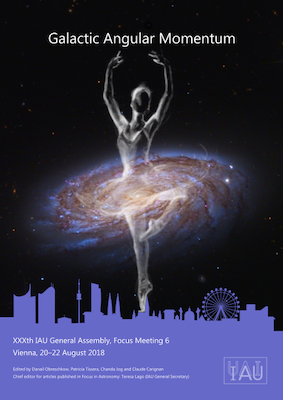The Focus Meeting (FM6) on Galactic Angular Momentum took place from Monday 20 August to Wednesday 22 August 2018 at the IAU General Assembly in Vienna (2018).
Talks and Proceedings
All talks are available here.
The full proceedings can be downloaded here as a single PDF-file, optimised for screen display or for double-sided printing (includes blank pages). The latter version is also available on Zenodo with the DOI number 10.5281/zenodo.1675471.
The individual chapters have also been published on Zenodo and can be downloaded via the following DOI numbers:
Obreschkow: 10.5281/zenodo.1481602
Combes: 10.5281/zenodo.1481291
Peebles: 10.5281/zenodo.1481378
Lagos: 10.5281/zenodo.1481532
Colless: 10.5281/zenodo.1481534
Pedrosa: 10.5281/zenodo.1481538
Fraternail: 10.5281/zenodo.1481543
Fall: 10.5281/zenodo.1481577
Posti: 10.5281/zenodo.1481572
DeFelippis: 10.5281/zenodo.1481554
El-Badry: 10.5281/zenodo.1481567
Genel: 10.5281/zenodo.1481598
Murugeshan: 10.5281/zenodo.1481548
Obreja: 10.5281/zenodo.1481545
Pulsoni: 10.5281/zenodo.1481552
Remus: 10.5281/zenodo.1481579
Rizzo: 10.5281/zenodo.1481556
Saha: 10.5281/zenodo.1481565
Sweet: 10.5281/zenodo.1481585
Welker: 10.5281/zenodo.1481550
Brief rationale
In the second decade of the new millennium, observational and computational studies of angular momentum (AM) have induced major progress in galaxy evolution theory. The rich and fast evolving diversity of AM-related topics and the need for bringing observers and theoreticians together is the main intention of this Focus Meeting.
Recent IFU surveys conclude that AM offers a more fundamental, albeit harder to measure, classification of galaxies than the classical Hubble sequence. The precise form of this new AM-based classification remains nonetheless a source of much argument. Many recent hydro-gravitational simulations (e.g. Illustris, EAGLE, Horizon, Magneticum, MAGICC, CLUES, NIHAO) contribute to this discussion, as do most major kinematic observing programs. Prominent examples include optical IFU/IFU-like surveys (e.g. Atlas3D, CALIFA, MaNGA, SLUGGS, PN.S, KROSS, SAMI Survey), interferometric radio surveys (e.g. at the VLA and GMRT) and many more kinematic observations on modern and future instruments (e.g. KMOS, MUSE, SINFONI, HECTOR, ALMA, NOEMA, JWST, SKA-precursors). The strong correlations between AM and morphology, as well as other galaxy properties, raise the question as to how the cosmic evolution of galaxies is paralleled, or even driven, by the evolution of AM. Answers are about to emerge from new high-z IFU observations on 8m-class telescopes, as well as from an array of cosmological simulations. Moreover, ongoing and near-future surveys are about to expand AM science to new scales: for the first time, enough spatially resolved velocity maps are available to systematically study the spatial distribution of the baryon AM in galaxies, which offers an extremely nuanced test of different galaxy evolution models. On large scales, galaxy surveys are about to become large and complete enough to test predicted weak correlations between AM and cosmic large scale structure.
Key topics
- The cosmological origin and evolution of angular momentum (AM)
- New precision measurements of galactic AM using integral field spectroscopy and interferometry
- Numerical simulations of acquisition, transport, growth and ejection of galactic AM
- Interpretation of the Hubble morphology sequence in terms of AM
- The role of AM in cold gas physics, turbulence, winds, clumps, star formation and black holes
- Alignment of galactic spin and cosmic large scale structure
Contact
If you have any questions concerning this Focus Meeting, please contact Danail Obreschkow (Chair) at [email protected].
